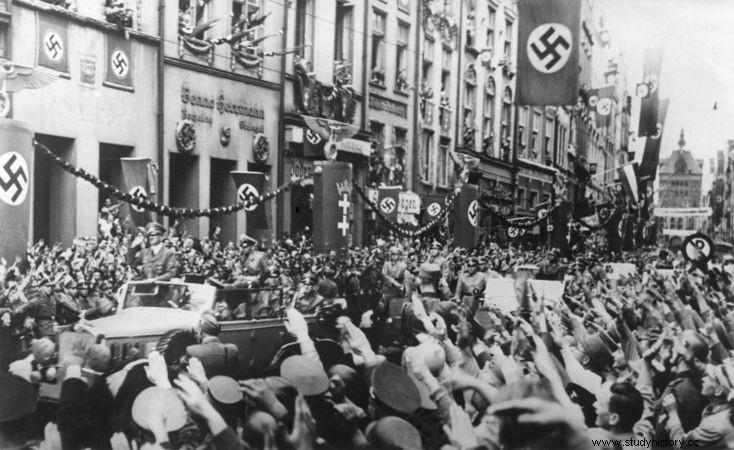
World War II was the greatest conflict in the history of humanity and, over six years, resulted in an approximate death toll of 60 million people (Some estimates claim that number may have reached 80 million). This conflict was characterized by its condition of total war, in which the nations involved mobilized all their resources to maintain their participation in it. The trigger that started the Second World War was the invasion of Poland on September 1, 1939.
Background
The main reason for the Second World War was the Germanic expansionism, put into practice by Adolf Hitler in the construction of the so-called “living space ” from Germany (lebensraum ). This idea consisted of building a territory dedicated to the development of the German people at the expense of dominating and exterminating other peoples, such as the Slavs.
The construction of this living space led Germany to completely overhaul its army - including, contrary to the provisions of the Treaty of Versailles - and to start the annexation of neighboring countries such as Austria and Czechoslovakia . As England and France had connived at this German expansionism, Hitler turned his attention to Poland.
Hitler's objective in Poland was to regain territories that belonged to Germany until the First World War, mainly aiming to recover the Polish corridor, which was basically a strip of Polish territory that separated the East Prussian Germany and where the city of Danzig was located .
Hitler's impassioned speeches against Poland led the Polish government to seek mechanisms to protect itself, since the country alone would be no match for German military might. Thus, the Poles left in search of an alliance with the British and French so that, in case they were attacked by the Germans, they would be protected by their allies. Despite the agreement, the alliance with Poland was a big bluff for the British and French, as it was more aimed at stopping Hitler than offering military support to the Poles.
The last step before the start of the conflict was the signing of a treaty between the Germans and the Soviets, known as the German-Soviet Pact. This agreement stipulated a ten-year period of peace between the two nations and guaranteed a series of important trade agreements for Germany. Furthermore, this pact secretly stipulated that Germany and the Soviet Union would invade and divide Polish territory between them.
This secret agreement between the two nations came about because neither of them accepted the existence of Poland, and, as Max Hastings states, "in the eyes of Berlin and Moscow, the Polish state owed its existence to only to Allied force majeure in 1919 and had no legitimacy”|1| . In the final weeks of August, the increasing hostility of the Germans evidenced their intention of war against Poland.
Invasion of Poland
The invasion of Poland officially took place in the early hours of September 1, 1939, with the Germans mobilizing 1.5 million troops , supported by 3,600 armored vehicles and 1,929 warplanes|2| . In addition to penetrating Polish territory, the Germans attacked the port city of Danzig with the battleship Schleswig-Holstein .
The German attack was justified by Hitler as a response to an alleged Polish aggression against a German radio station located in a border town. This alleged Polish attack was actually a false flag operation , that is, an operation forged by the Germans to serve as a pretext for an aggression against Poland. The alleged Polish soldiers who attacked the German radio station at Gleiwitz were actually drugged prisoners in a German concentration camp.
The German attack caused England and France to declare war on Germany on 3 September. The British and French were extremely hesitant to issue an ultimatum to Hitler, but internal arguments led to war being declared. This declaration of war surprised Hitler, who had been convinced by the assurances of Ribbentrop, minister of international relations, that England would back down and not declare war.
The German invasion caught the Poles with a partially demobilized army, as Poland had been guided by France and England not to mobilize their forces so that Hitler would not use it as a pretext for an attack. . This choice turned out to be detrimental to the Poles, since, on the day of the invasion, only a third of the army was mobilized and positioned in the defenses|3| .
The Allies (at this time, the UK and France) expected the Polish resistance to withstand the German onslaught for a few months, however, in a matter of weeks Poland collapsed. The success of the Germans against the Poles was explained, in part, by the use of the blitzkrieg , a blitzkrieg tactic, which was innovative at the time. In addition, the Polish military adopted a mistaken defense strategy, which facilitated the German victory.
While fighting the Germans, the country was invaded on September 17 by the Soviet Union. As the Poles did not expect a Soviet attack, Poland's eastern borders were totally unprotected. This is because, according to Antony Beevor, “the idea of a coordinated double invasion between the Nazi and Soviet governments seemed too absurd a paradox”|4| .
Polish defeat became official on September 28, when the capital, Warsaw, surrendered to Nazi Germans. During this German attack, the British and French failed to keep their promise, and the support promised to the Poles was never sent. Poland therefore fought alone against Germans and Soviets (against the latter from the 17th). With this victory by Germany, a period known as the “false war” began, in which there was little confrontation and which only ended with the beginning of the invasion of Norway in April 1940.
|1| HASTINGS, Max. Hell:the world at war 1939-1945. Rio de Janeiro:Intrinsic, 2012, p. 16.
|2| Ditto, p.18.
|3| BEEVOR, Antony. The Second World War. Rio de Janeiro:Record, 2015, p. 36.
|4| Ditto, p. 36.
*Image Credits:Everett Historical and Shutterstock
Take the opportunity to check out our video lessons related to the subject:
